Visit your favourite destinations |
| A Report from birdtours.co.uk |
Brazil, 18 October - 30 November 2004,
( Pantanal, Rio Cristalino, Atlantic forest of S.E Brazil and Espirito Santo)
Moira and Graeme Wallace Edinburgh Scotland. dacnis@mwallace.freeserve.co.uk
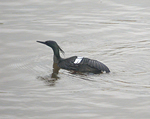 |
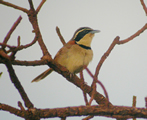 |
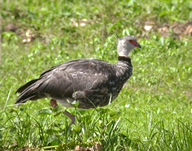 |
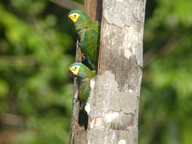 |
|
Brazilian Merganser |
Collared Crescentchest |
Southern Screamer |
Red-bellied Macaw |
Large versions of all the pictures in this report can be found on www.worldbirder.com
STRUCTURE AND HEADINGS OF THE TRIP REPORT
BooksTrip Reports
Annotated Species List. (pdf 216kB)
Over the last four years birding has taken us to 17 countries across all continents. Having only visited South America once, there were several endemic South American families that we had not encountered. We therefore planned an extended trip to Brazil that would offer the chance of 5 new families, a host of species and some of the rarest and most beautiful birds on the planet. However, Brazil is a vast country and it would require several trips to get to grips with the avian life comprehensively; so, for this first trip, with our friend Chris Lodge, we visited parts of the country which were reasonably easy logistically, offered a variety of habitats, a high degree of endemism, or where there were particular critically endangered species to be found. The trip encompassed four broad segments;
The itinerary worked well and during our 40 days in Brazil we recorded just under 700 species including 425 lifers, which in turn included 90 of the 100 possible trip endemics. (Brazil has 190 or so in total). Highlights included the critically endangered Brazilian Merganser and Cherry-throated Tanager, the sight of 40 Hyacinth Macaws coming to roost at dusk in the Pantanal, Amazonian Umberellabird on 5 separate occasions at Cristalino, pre-dawn Rusty-barred Owl at Agulhas Negras Road, the fabulous Frilled and Festive Coquettes, Black and Gold Cotinga and amazing views of tapaculos and antthrushes. On the mammal front several sightings of Tapir, Maned Wolf and the strange Giant Anteater at Canstra were also memorable. We didn't miss too much although the endemic Bare-eyed Antbird and Black-spotted Bare-eye were the biggest dips and our efforts to see Black-throated Piping Guan went unrewarded.
The table below offers a summary of the distribution of species across the four segments of the trip
| Location |
No of Species Seen |
New for the Trip |
Endemics |
| Pantanal |
265 |
265 |
2 |
| Rio Cristalino |
150 |
110 |
5 |
| SE Brazil |
352 |
262 |
61 |
| Espirito Santo. |
205 |
50 |
31 |
Pantanal
This huge annually flooded wetland, transected by the Transpantaniera, the 118 wooden bridged road to nowhere, is internationally famous and needs little introduction. Running 145 km from Pocone in the north to Porto Jofre at its southern terminus the Transpantaniera cuts through this vast alluvial plain (much of which is now cattle pasture) allowing access to the herons, egrets, storks, ibises, spoonbills and the other waterbirds for which it is renowned but also to patches of semi-deciduous forest and buriti palm groves - home to the magnificent Hyacinth Macaw - the largest parrot in the world. We followed the road stopping for 2 nights on the way south at the excellent Fazenda St Teresa on the Pixaim River, birding in the remnant forest nearby (which was infested with rampant mosquitoes) and by canoe along the river. Continued south, deep into the Pantanal, with an overnight stay at the fisherman's lodge at Porto Jofre before returning north to break the journey again at Faz. St Teresa. Whilst all the expected bird species were present the actual numbers of birds was considerably lower than the spectacle of thousands of waterbirds suggested in other literature. Accomodation in transist through Cuiaba was at the Hotel Diplomata which is locate 2 minutes from the airport and has a transfer service
Key species include; Jabiru, Southern Screamer, Maguari Stork, Sunbittern, Limpkin, Black Skimmer, Chestnut-bellied Guan, , Bare-faced Curassow, Hyacinth and Golden-collared Macaw, Yellow-chevroned, Peach-fronted, Monk &Nanday Parakeet, Great Potoo, Nacunda Nighthawk, Toco Toucan, Red-billed Scythebill, Chotoy & Rusty-backed Spinetail, Great Antshrike, Rusty-backed Antwren.
Amazonia
Although some way from the mighty Amazon itself, Rio Cristalino Jungle Lodge lies in pristine true Amazonian forest. Much of the reserve is terra firme forest where the vegetation is adapted to the poor nutrient levels in the thin soil, together with annually flooded areas of varzea forest (found by white water rivers such as the Teles Pires) and igapo forest (found by black water rivers as at Cristalino). With a bird list of around 570 it offers almost limitless potential and is easily accessed from Cuiaba (also the portal for the Pantanal). There is an excellent trail system, a 50metre tower and canoe transport available daily.
As can be seen from the table in the Introduction above we found birding at Cristalino quite testing. Perhaps it was the time of year but canopy and sub-canopy flock activity seemed low, birds sluggish and unresponsive and in our 6 days there were probably only 3 flocks of substance, otherwise it was trying to find single birds as we walked the trails. Disappointingly we did not encounter any "eciton" ant swarms meaning that "obligate" antbirds were almost impossible to find and in fact no-one had seen an ant swarm in the preceding 25 days. On the upside we did see Amazonian Umbrellabird on 5 separate occasions, Dark-winged Trumpeter twice and the curassows, macaws, parrots, toucans were splendid. On the mammal front Tapir was seen almost daily. See www.cristalinolodge.com.br for comprehensive bird and mammal list.
S.E Brazil
Restricted to the Brazilian coastal region and inscribed on the UNESCO World Heritage list in 1999, the Atlantic forests of S.E Brazil are among the world's richest rainforests in terms of biodiversity. The Atlantic forests have suffered the impacts of colonisation, farming, cattle grazing and urbanisation and now, of the original Atlantic forest, which comprised over 1,250,000 square kilometres and occupied some 15% of Brazil, less than 8% (or 90,000 km2) still remain. Partially isolated since the Ice Age, the Atlantic forests have evolved into a complex ecosystem with exceptionally high endemism It is also the region in Brazil with the greatest number of endangered and threatened species. Brazil's Atlantic forests are perhaps the most endangered forest ecosystem on earth. Intervales and Itatiaia offer among the best examples of this habitat.
Intervales
Perhaps because it was the first Atlantic forest site we visited, maybe because of Edson & Luis (the local and very good guide), or perhaps just because the birds were so great, this was our favourite site of the entire trip. About 3 hours drive from Sao Paulo, Intervales is in two sections, an upper part open to the public on the slopes of Serro Do Mar at about 300 metres and a closed lower level section. Edson did manage to obtain permission for us to go to the lower level although because there is no road linking the 2 sections one has to leave the upper part of the park and drive a considerable distance to access the lower levels. The upper level of the park has extensive driveable trails and accommodation is available in a comfortable lodge within the park with a restaurant close by.
Key species here include; Rufous-thighed Kite, Mantled Hawk, Black-fronted Piping Guan, Blue-bellied Parrot, Rusty-barred & Black-banded Owl, Long-trained Nightjar, Saw-billed & Dusky-throated Hermit, Sombre Hummingbird, Brazilian Ruby, Strip-breasted Starthroat, Crescent-chested Puffbird, Rusty-breasted Nunlet, Helmeted Woodpecker, Rufous-breasted & Tawny-throated Leaftosser, Giant, Tufted, Large-tailed & White-bearded Antshrike, Rufous-backed, &Star-throated Antwren, Ochre-rumped Antbird, Squamate Antbird, Such's Antthrush, Black-cheeked Gnateater, Spotted Bamboowren, Slaty Bristlefront, Mouse & White-breasted Tapaculo, Hooded & Black-headed Berryeater, Oustatlet's Tyrannulet, Eye-ringed & Hangnest Tody-Tyrant, Russet-winged Spadebill and a host of tanagers..
Itatiaia
This well known site offers mid to high level Atlantic forest on steep slopes rising up the to the peaks known as Tres Picos. We birded the Tres Picos and Maromba trails and other random parts of the park as well as the feeders of Mr Igold Knock at his house not far down the hill from our base the Hotel Simon . There are many places to stay in Itatiaia and our base ,the Hotel Simon, www.hotelsimon.com.br was a vast and somewhat faded throwback to the more elegant1950s.However it was comfortable, the staff amazingly accommodating, providing breakfast at 03.30 on successive mornings and the present owner is knowledgeable about and very concerned for the local avian and mammal life.
Key species here include; Tawny-browed Owl, Frilled Coquette, Brazilian Ruby, Surucua Trogon, White-eyed Foliage-gleaner, Spot-breasted Antvireo, Ferruginous & Bertoni's Antbird, Rufous-tailed (Brazilian) Antthrush, Such's Antthrush, Variegated Antpitta, Slaty Bristlefront, Black-goggled Tanager, Golden-chevroned Tanager, Chestnut-bellied Euphonia, Green-headed Tanager, Brassy-breasted Tanager, Gilt-edged Tanager, Swallow Tanager
Agulhas Negras Road.
It takes about an hour to drive down from Itatiaia and back up along the twisting road to Coxambu before you reach the turn-off to the forest covered slopes of the lower elevations of the Agulhas Negras Rd which, over its 17kms, rises gradually through Atlantic forest, araucaria stands and eventually to stunted growth on its upper levels. This proved to be a great place to bird.
Key Species; Barred Forest Falcon, Rusty-barred and Striped Owl ( in the farmland below), Plovercrest, Araucaria Tit-Spinetail, Itatiaia Thistletail, Buff-browed Foliage-gleaner, Rufous-backed Antvireo, Variegated Antpitta, Mouse-coloured Tapaculo, Black & Gold Cotinga, Black-capped Piprites, Serro do Mar & Mottle-cheeked Tyrannulet, Velvety Black Tyrant, Thick-billed Saltator.
Canastra
The Canastra plateau (Canastra upper)is a massive rock bastion that sits impressively several hundred meters above the surrounding plain, largely now farmland but with some remnant cerrado. Bordered in places by gallery forest, the Rio Francisco meanders its way across the plateau's grassland before plunging over the sheer cliffs to form the Casca d'Ante waterfall, then to continue on its way amidst the lower level cerrado gallery forests. The key species here is the critically endangered Brazilian Merganser, best looked for on the upper level in the last 200-300 metres of the Rio Francisco that lead to the waterfall or from vantage points along the lower level river. Giant Anteater and Maned Wolf provide mammalian interest. Accommodation was in the comfortablePousada Barcelos www.serracanastra.com.br in Sao Roques de Minas, 6km from the park entrance.
Key species include; Brasilia Tapaculo, Spotted Nothura, Peach-fronted Parakeet, Black-eared Parrotlet, Sickle-winged & Scissor-tailed Nightjar, Firewood-gatherer, Sharp-tailed Streamcreeper, Black-capped & Large-billed Antwren, Dusky-tailed Antwren, Sharp-tailed Tyrant, Grey-backed Tachuri, Cock-tailed Tyrant, Ochre-breasted Pipit, Campo Miner & White-striped Warbler.
Cipo
About 100kms north of Belo Horizonte and 2-3kms up the steep road beyond the village of Cipo there is a parking area/lay-by on the left. Park here and walk up the grassy boulder and rock strewn hillside to look for the 3 key birds of this area. There seemed to be plenty of hotels in Cipo. We stayed in the Pousada Chaco do Serra www.guiaserradocipo.com.br which was perfectly adequate and ate dinner in the village.
Key species; Hooded Visorbearer, Lesser Pampa Finch & Cipo Canastero
Pereque, Ubatuba & Environs
Coastal site(s) at Pereque, Faz Capricorn, Faz Angelim and Folha Seca. Nothing to add to Jeremy Minns or John van der Woude's notes other than at Folha Seca there is a house owned by a retired gentleman called Jonas who welcomes visitors to his hummingbird feeder.
Key Species; Black-hooded Antwren, Buff-browed Purpletuft, Long-billed Wren, Festive & Frilled Coquette, White-chinned Sapphire,.
Espirito Santo (E.S.)
Linhares/Sooretama
We selected a number of sites to visit in E.S. based mainly upon habitat and species diversity and the location of one critically endangered species. The Linhares Forest Reserve and Sooretama Biological Reserve together represent the largest remnant of lowland forest in eastern Brazil. This tract contains 25% of the forested area left in E. S., and is one of the last remaining refuges for several threatened plant and animal species. This uniqueness together with an Amazonian influence make them a fascinating place to bird. Accommodation the first night was supposedly in the up market chalets within Linhares Reserve but despite booking well in advance the management there elected to bump us to poorer quality rooms because there was a corporate do taking place. The other rooms were fine but the attitude frankly unwelcoming. On the other hand the Los Pagos hotel in Linhares town 10-15 minutes drive was comfortable and the staff helpful. You are required to pay afee of $35 per person per day to gain access to Linhares and once there it is obligatory to take a company paid guide who in our case added little or no value.
Key species; White-necked Hawk, Red-billed Curassow, Red-browed Parrot, Blue-throated Parakeet, Golden-tailed Parrotlet , Blue-bellied Parrot, Striated Softtail, Plumbeous Antvireo, Black-hooded Berryeater, Cinnamon-vented Piha, White-winged Cotinga and Banded Cotinga.
PindobasIV
Until recently the only known site for the critically endangered Cherry-throated Tanager. A second, although less reliable site, has now been discovered at Caetes. Birdlife estimate the tanager population to be between 50 -249 birds although only a handful of birds have ever been seen, usually in the Pindobas tanager flock. The bird seems to require humid montane forest within a narrow altitudinal range of 900 to 1100 metres. The second site at Caetes beyond the golf course on the Vargem Alta Road lies within this range. Accommodation in the Alpes Hotel in the small town of Vendo Nova do Imigrante.
Key Species; Cherry-throated Tanager, Oustatlets Tyrannulet, Russet-winged Spadebill, Cinnamon-vented Piha, Golden-tailed Parrotlet, Spot-billed Toucanet, Giant Antshrike. Such's Antthrush, White-bibbed Antbird, Hooded Berryeater, Blue and Pin-tailed Manakins, White-collared Foliage-Gleaner, Pale-browed Treehunter, Sharpbill,
Nova Lombardia.
Also know as Augusto Ruschi this remnant mid -elevation Atlantic forest site lies close to the small town of Santa Teresa and is home to a number of restricted range species and endemics. Two little used dirt roads radiate from the new HQ - the right hand track had better forest.
Accommodation was in the hills above the town in a nice bed and breakfast place called Vitta Verdi
Key Species; Planalto Hermit, Frilled Coquette, Sombre Hummimngbird, Brazilian Ruby, Amethyst Woodstar, Spot-billed Toucanet, Yellow-eared & Yellow-throated Woodpecker, Spot-breasted Antvireo, Short-tailed Antthrush, Variegated Antpitta, Black-billed Scythebill, Oustatlet's Tyrannulet, Russet-winged Spadebill, Wied's Tyrant Manakin, Cinnamon-vented Piha, Sharpbill, Rufous headed, Golden-chevroned, Gilt-edged, Burnished Buff and Black-goggled Tanager.
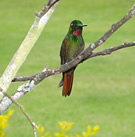 |
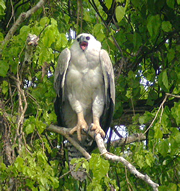 |
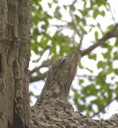 |
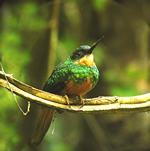 |
|
Brazilian Ruby |
Harpy Eagle |
Great Potoo |
Rufous-tailed Jacamar |
General
In the initial stages we intended to undertake this trip on a wholly independent basis. However, as our plans progressed, difficulties in sourcing essential tapes, complete absence of Portuguese language abilities, concerns over navigating hire cars in, out and around mega-metropolises like Sao Paulo meant that our thoughts turned to using local guides. Internet trip reports and personal contacts suggested that very good guides were available at most locations and that, in the end, is what we did. It cost more but we saw a greater number of species than we would otherwise have done and it made the whole affair much more relaxing. Short notes follow on the guides used on each sector together with indicative costs.
Pantanal.
Led by Braulio Carlos, the Pantanal Bird Club www.geocities.com/TheTropics/Cabana/6292/ offer fixed date departures for groups up to a maximum of 8 participants and appear to be the leading bird tour organisation in this area. They also guarantee that the trip will depart even if there is only one participant. An all inclusive 6 day/7 night trip to the Pantanal and Chapada dos Guimaraes cost us $1050 per person.. Although not greatly enamoured of group tours we signed up and were glad that we did. Braulio proved to be a professional, highly qualified guide who knows the calls intimately and is prepared to put in a lot of work to make the tour a success. Accommodation , food, river trips were all excellent and when the van broke down at Chapada, Braulio arranged a replacement within 2 hours. Our only criticism would be that at times Braulio could be somewhat impersonal but have no hesitation in recommending him. Amazonia.
In recent years Rio Cristalino www.cristalinolodge.com.br has built up an admirable reputation as a highly accessible, comfortable Amazonian birding destination. With a bird list of around 570 it offers limitless potential and is easily accessed from Cuiaba (also the portal for the Pantanal). Included in the costs are the services of local and/or English speaking volunteer guides but there is a degree of pot luck in the skill levels and areas of interest of the volunteer guides. We elected to book, at additional cost, the exclusive services of Francisco; Cristalino's leading, although non English speaking guide. Francisco proved to be hard working , able, and most of all a really nice guy. We highly recommend Cristalino as a destination; it's a great location in pristine forest, the team there are highly professional and the food and accommodation excellent .Perhaps as Lambert suggests, a stay of 10 days rather than the standard week, may reap dividends. The cost Alta Floresta - Alta Floresta was $950 per person plus around $100 each for the exclusive arrangement with Francisco all of which represented good value. Depending on budget one can either take the 1.5 hour flight from Cuiaba - Alta Floresta return for around $225 or take the 11-12 hour bus ride at $70 return.
S.E. Brazil
In order to do justice to this special area we retained the (somewhat expensive) services of Edson Endrigo www.avesfoto.com.br. as other birders who we knew and had used his services spoke of him glowing terms. He was not to let us down and the 15 days we spent with him were just extraordinary. His knowledge of the birds and their calls, which he has really only been studying for 4 years, was exceptional but his greatest talent seemed to be his innate understanding of what a bird was going to do.. On innumerable occasions when a species responded, apparently very close, he would wait a few moments an say "No not this one we'll find another one later - let's go!" He was exceptional in many ways, very accommodating, hard working with tremendous energy and a great sense of humour. With Edson we visited Intervales (where in the first afternoon session of 5 hours he found a new species every 7 minutes), Canastra, Cipo, Itatiaia, Agulhas Negras and Ubatuba together with an unscheduled expedition to Cananeia when we ran out of birds, elsewhere. Edson charged an all inclusive $200 per person/per day; this was non-negotiable and worth every cent. His main interest is photography and we gained the distinct impression that while he will continue to run fixed departure tours he may be less inclined to take on 2-3 week private trips.
Espirito Santo
One of our prime targets in Espirito Santo was the critically endangered Cherry-throated Tanager . Following its rediscovery it was, until recently, known only from one place ( PindobasIV) but a second site
( Caetes) has now been identified. However, both sites are difficult to find and can only be accessed through locked gates. At present it seems that the landowners will only trust the keys to the biologists Ana &Pedro ( who were part of the group that rediscovered the bird) so in reality if you want the chance to see the Cherry-throated Tanager you will probably need to use their services. Doing this will also increase significantly your chances of seeing the bird. Ana & Pedro can be contacted at orignat@terra.com.br and their web site details are www.originalisnatura.com.br". In addition Ana & Pedro can act as guides throughout Espirito Santo particularly at Sooretama & Linhares but also other places. A& P charged us $1250 per person for an 8 day/7 night trip to Nova Lombardia, Linhares/ Sooretama and PindobasIV/Caetes including pick up and drop-off at Vitoria airport. They organised a good trip, know the locations and calls very well and worked hard on our behalf. However, sometimes on the trails it seemed that they thought they were still biologists undertaking their own fieldwork rather than acting as paid guides. In this regard were not as professional as the other organisations that we used. All in all however they did a good job and we can recommend them.
Books
Birding Brazil - A Check-list and Site Guide by Bruce Forrester. 1993 [ ISBN 0-9521567-0-9 ], Although a groundbreaking text of its time it is now dated but remains a useful guide to 42 of the principal birding areas/sites throughout Brazil; it contains useful maps and site checklists.
All The Birds of Brazil - An Identification Guide by Deodata Souza. 2002 [ ISBN 85-86967-04-1] Often scorned because of the relatively poor quality of its plates, which admittedly are not great, to date this remains the only book where virtually all the species occurring in Brazil can be found in one handy guide. In many ways a magnum opus it contains reference maps and illustrations of some 1650 + species and, despite taxonomic developments, we found it a valuable resource in getting to grips with Brazil's overwhelming birdlist.
The Birds of South America Vols I &II By Robert Ridgely and Guy Tudor 1994 Oxford University Press [ISBN 0-19-857217-4] The first two volumes of the as yet unfinished four volume set contains excellent plates and species descriptions. Too weighty to be field guides they make great if pricey pre and post tour reading .
Handbooks of the Birds of the World Lynx Edicions Vol8 of this amazing series contains all the antbirds and tapaculos. The plates are stunning and when digipic-ed can be a great private identification guide for use in the field.
Internet
There are many sources of information on the web but foremost amongst those for Brazil is Arthur Grossett's website www.arthurgrosset.com which, as well as providing great photos of Brazilian birds, acts as an entry portal to Jeremy Minns Site Notes which contain invaluable in-depth information about dozens of Brazilian Bird Sites (key species, directions, entry regulations contact numbers and accommodation) Supporting this excellent resource are the more restricted but infinitely detailed trip reports by the excellent John van der Woude http://johnbirding.wolweb.nl which contain detailed maps as well as GPS references to where key species were seen. For more trip reports the Birdtours www.birdtours.co.uk and Surfbirds www.surfbirds.com websites are excellent ; Eurobirding www.eurobirding.com provides a structured bird report search engine and for more general information Fatbirder www.fatbirder.com and Where do You Want to Go Birding Today www.camacdonald.com are unrivalled.
We were delighted to be travelling once again with Chris Lodge whose sharp eyes and dry sense of humour have always added zest to our trips. We thank him for his company and wish him well in his developing skills as a wildlife artist - check out his paintings at www.birdingart.com . Thanks also go to Arthur Grossett, Jeremy Minns and John van der Woude for sharing their detailed site information on the websites (referred to above); such information was an invaluable resource when planning the trip. Ashley Banwell very kindly shared his tapes of night birds.
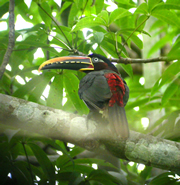 |
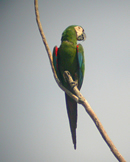 |
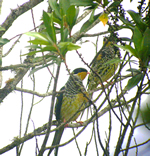 |
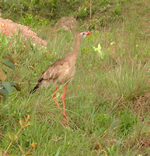 |
|
Chestnut-eared Aracari |
Chestnut-fronted Macaw |
Swallow-tailed Cotinga |
Red-legged Seriema |
18 October (Day1)
Departed Edinburgh 12.45 on Lufthansa for Frankfurt. Killed time at the airport finally boarding the connecting overnight flight to Sao Paulo which departed 22.30.
19 October (Day2)
Following he 11.5 hour flight arrived Sao Paulo(Garulhos) at 06.00 local time, transferred to the domestic terminal for the 09.00 flight to Cuiaba where we met up with Braulio Carlos of Pantanal Bird Club around 11.30 and headed off for the 1.5 hour drive to Pousada Currupira das Araras. Fortunately the huge immature female Harpy Eagle ( by now 10 months old and full grown) was quickly found perched close to the nest. Great start! We remained at the site until dusk seeing about 40 species with little effort before returning to Cuiaba for an overnight stop in the Hotel Diplomata.
Highlights; Harpy Eagle, Red-shouldered Macaw, Blue-headed Parrot, Golden-chevroned and Dusky-headed Parakeet, Spix's Guan, Toco Toucan, Planalto Woodcreeper.
20 October ( Day3)
Met up with the other 4 members of the Pantanal party and headed off to Pocone which marks the beginning of the Transpantaniera. Birded our way along the road stopping frequently seeing many species, including the first new family of the trip, a flock of 8 Greater Rhea, before arriving around 13.00 at Faz. St Teresa on the Pixaim River, our base for the next 2 nights. Blazing hot in the middle of the day so thankfully caught up on some sleep before embarking upon a lazy drift down the Pixaim river until dusk with a group of 11 Giant Otters the undoubted highlight. Although there were not the great flocks of waterbirds nor the great spectacle of huge numbers taking flight over the Pantanal that we had anticipated, neverthelss,100 species by the end of the day marked an excellent start.
Highlights; Greater Rhea, Ornate Hawk Eagle, Swallow-tailed Kite, Peach-fronted Parakeet, Long-tailed Tyrant, Maguiri Stork, Matto Grosso & Band-tailed Antbird, Red-billed Scythebill, Helmeted Manakin.
21 October ( Day4)
Breakfast at 04.45 followed by 6 hours birding in the remnant forest by the Pixaim River. Whilst the birding was excellent the forest was very hot and we were plagued by mosquitoes that appeared impervious to any repellent. Similar pattern to yesterday; a rest period until 16.00 followed by another and much longer boat trip culminating with great views of a tapir slipping effortlessly across the river backed by a magnificent sunset.
Highlights; Glittering-throated Emerald, Scaly-headed Parrot, Russet-crowned Crake, Undulated Tinamou, Ferruginous Pygmy Owl, Large-billed Antwren, Pearly-vented Tody Tyrant, Bare-faced Curassow, Blue-fronted Piping Guan, Monk Parakeet, Jabiru, White-faced Whistling Duck, Paraque.
22 October ( Day5)
Similar early start to yesterday, this time walking the grassland and open country tracks surrounding Faz. St Teresa before driving a little way south along the Transpantaniera where we found the main target of the day and indeed possibly the trip. Four Hyacinth Macaws perched in a tree close to the road squawking loudly and hanging on grimly, as the by now high wind buffeted the branches. Spectacular, colourful and full of character they were worth the trip alone! They are quite splendid birds. Back to the fazenda for lunch taking time out to admire the Great Potoo at his staked out roost before heading off to cross the 97 bridges between us and the end of the Transpantaniera 80 kilometres south at Porto Jofre. Weather deteriorated, wind strengthened further and the sky grew black illuminated vividly by massive streaks of forked lightning. The storm broke over us turning the road to a kind of slippery porridge. At one point we slid off the road and had to push the van back and the remaining narrow wooden bridges had to be crossed with extreme caution. However as we arrived at the upmarket lodge in Porto Jofre for an overnight stay the weather brightened to allow us great views of the 12-15 resident Hyacinth Macaws.
Highlights; Hyacinth & Golden-collared Macaw, Peach-fronted & Nanday Parakeet, Great Antshrike, Chotoy Spinetail, Chestnut-bellied Guan, Orange-bellied Troupial, Pale-crested and Green-barred Woodpecker, White-bellied & Rusty-collared Seedeater.
23 October ( Day 6)
Enlivened by the dawn chorus from a troop of Black & Gold Howler Monkeys we set out around 05.30 to bird our way back along the Transpantaniera, then along a side track past the campsite, down to the river and eventually back to the lodge. Some nice South American species, trogons, aracaris, jacamars and parakeets all fairly easily found and seen. Our departure was delayed by major repairs to the second bridge north but eventually we crossed over, driving 15-20 kilometres before turning left onto a side road that leads to Santa Isabelle Farm where we were treated to the spectacle of 30-40 Hyacinth Macaws coming in to roost in the palms. As night fell back at the road junction Braulio tried the territorial call of jaguar and despite some of the group claiming a distant response we were not to be lucky. A couple of perched Great Horned Owls were nice. Fast drive back to Fazenda St Teresa arriving around 20.00.
Highlights; Laughing Falcon, Fawn-breasted & Moustached Wren, Chestnut-eared Aracari, Blue-crowned Trogon, Cinereous-breasted Spinetail, Golden-chevroned Parakeet, Common Tody Flycatcher.
24 October ( Day 7)
Departed 06.00 paying homage again to the Great Potoo, and headed north on the Transpantaniera birding along the way with nice views of our second new family as a Red-legged Seriema showed well but Great Rufous Woodcreeper was to disappoint. Arrived back in Cuiaba around 11.30 and following lunch departed for Chapada dos Guimaraes reaching our uninspiring motel, the Pouasada Laura Vicuna, an hour later. Enforced rest saw us finally back out at 16.00 to Chapada NP. where we whiled away the remainder of the day watching Blue-winged Macaws flying around the sandstone cliffs and what were probably Biscutate Swifts circling high before plunging in to roost behind the waterfall, Heavy rain brought an end to the day and a bolt of lightning nearly put an end to us, missing the vehicle by only a metre or two.
Highlights; Red-legged Seriema, Blue-winged Macaw, Planalto Woodcreeper, Blue-crowned Motmot, Swallow Tanager, Planalto Hermit, Black-crowned Tityra, Burrowing Owl,
25 October ( Day 8)
Breakfast 04.45, out at 05.15 as dawn broke over the cerrado on the road to Agua Fria. Birds came steadily including the first tapaculo of the trip, Collared Crescentchest which instead of exhibiting its usual skulking behaviour, chose to call loudly from a prominent branch at the top of a bush. Small-billed Tinamou proved less obliging but the recently described Chapada Flycatcher was a good, if dull, bird. Just as the sun was getting really hot the van broke down terminally and a replacement vehicle and mechanic had to be called for from Cuiaba. Some of us chose to walk the road until the rescue van arrived but saw little. Continued to the spectacular viewpoint and then returned to the motel. Once the day cooled we drove to a small (un-named) patch of remnant forest which as well as showing some good birds allowed Braulio to demonstrate his considerable birding skills by walking up to a bush at dusk to announce that there was a Tropical Screech Owl lurking - which there was. He had recorded other bird moments before and, when playing back, heard the owl calling quietly in the background, looked around for a suitable place and calmly produced the bird.
Highlights; Pale-breasted Spinetail, Rufous-winged Antshrike, Rufous-sided Pygmy Tyrant, Black-faced & White-rumped Tanager, Southern Antpipit, Band-tailed Manakin, Common Potoo.
26 October ( Day 9)
05.15 drove to a patch of gallery forest in a valley accessed from a turning to the left off the main road back to Cuiaba. Birds were very high in the canopy making id. tricky and a somewhat frustrating morning concluded with poor views of White-backed Fire-eye and no sign of Sharp-tailed Streamcreeper. Back to the motel mid morning until the start of the mid afternoon drive back to Cuiaba. Somewhere along the main road back to Cuiaba we turned left on to a dirt road that wound its way through scrubby vegetation in an area called Coxipo do Ouro bordering closed off tracts of military land. Spent a couple of hours leisurely birding here without seeing anything new and returned early evening to the Diplomata Hotel in Cuiaba.
Highlights; Tataupa & Red-winged Tinamou, Saffron-billed Sparrow, Planalto Slaty Antshrike.
27 October ( Day 10)
Long lie before travelling the short distance to the airport for our midday flight to Alta Floresta where we were met by Zulieca from Cristalino Lodge and taken to Alta Floresta Hotel for lunch. Headed off around 03.30 in pouring rain, picked up our guide Fransisco and drove through cattle country before reaching the Teles Pires river. As the rain thankfully abated we boarded the boat, first crossing the RioTeles Pires before heading up the Rio Cristalino. Almost immediately, to our astonishment, the undulating woodpecker-like flight of bird heading towards us was clearly identifiable as an Umbrellabird as it flew directly over head and as we reached the lodge Red & Green Macaws perched above the accommodation clearing were nice. Checked in to the rooms and spent some time getting to know Fransisco and hear from him about Cristalino and its birds. Our lack of a common language meant this had to be done with a mixture of Portuguese, English, Italian, Spanish & sign language but gradually we began to sort it out.
28 October ( Day 11)
On a cool and overcast morning we headed downriver , magnificent pristine forest all around, to the New Trail hearing Zigzag Heron and seeing Red-throated Piping Guan. Reached the trailhead where Zigzag was calling from the other bank but would not be lured into view. 20 metres down the trail we all suddenly heard a strange mixture of enthusiastic gurgles, chuckles and grunts close to the trail. We stopped and a group of around 10 Dark-winged Trumpeters, oblivious or unaware of our presence, walked slowly by. Amazonian Umbrellabird and our third new family -Trumpeters, was a great start to our time at Cristalino but as we walked the trail seeing and hearing little the phrase "counting one's chickens" came uncomfortably to mind. It would be another 75 minutes before we saw our next bird, a pattern repeated for the remainder of the morning. Emerged from the forest into bright sunshine back at the lodge around 12.30 but afternoon rain delayed the start of our boat trip up river until 16.00 Leisurely birding from the boat until dusk where we tried, once again unsuccessfully, to see the Zigzag Heron which was calling across the river from the jetty.
Highlights; Blue & Yellow Macaw, Kawalls Amazon, Dark-winged Trumpeter, King Vulture, Bat Falcon, Fiery-capped Manakin, Blackish Antbird, Snethlage's Tody Tyrant, Straight-billed Woodcreeper.
29 October ( Day 12)
Out before dawn on the boat to listen for Zigzag Heron. Not far downstream we heard one calling , moored the boat close to the bank under the overhanging vegetation. Although almost above us the slow movements and secretive nature of this bird made it difficult to observe but eventually good looks for all. Back for breakfast around 05.15 and then out to the 50 metre high Tower a short distance from the lodge. Although very safe and well designed (it puts the tower at Danum to shame) it is nevertheless something of a challenge for those who have no head for heights. Once at the top as the sun climbed and burned off the early morning mist it revealed a wonderful vista of unbroken rainforest in all directions. As the morning warmed the birds began to appear with the endemic Tooth-billed Wren putting in an early and close appearance, followed by Black-girdled Barbet, and with the telescope great views of Spangled Cotinga. Activity began to tail off around 09.00 and we descended to walk sections of the Caja, Taboca and Bamboo Trails which seemed quiet with an uncooperative Black-faced Anthrush taking ages to show. In the afternoon we took the boat to The Island at the confluence of the Cristalino and Teles Pires rivers where Glossy Antshrike and a perched Umbrellabird were excellent but soon after rain brought the day to an end.
Highlights; Scarlet & Red & Green Macaw, Blue-headed & Mealy Parrot, Glossy Antshrike Bare-necked Fruitcrow, Spangled Cotinga, Black-girdled Barbet, Black-necked & Lettered Aracari, White-browed Antbird,
30 October ( Day 13)
Continuous overnight rain persisted into the early morning and we awoke to a drizzly grey dawn. We were to bird an area upriver known as the Serra, a series of rocky outcrops, but delayed our start until the rain eased a bit. After a short climb, arrived at the top of the Serra around 07.30 but misty conditions and continuing drizzle meant it was difficult to see birds well and so we descended to the Cacao Trail having identified little. On the way down Moira fell, jarring her back so went back directly to the lodge leaving Chris, Fransisco and I to walk the trail. It proved to be a desperate morning with no flocks and only single birds here and there. Razor-billed Curassow brightened the late morning as did the discovery of a mini swarm of small ants which raised hopes of "obligate antbirds" but nothing showed. Went back to the same spot in the afternoon but it soon became evident that the mini swarm had largely dispersed and that they were the wrong kind of ants anyway. Returned to the lodge a bit downhearted, a mood not helped when we discovered that almost one month had elapsed since anyone had reported an ant swarm on any trail. Day 13 had not been a good day!!
31October ( Day 14)
The day dawned bright and clear as we headed upstream to the Haffer Trail, once again enjoying views of a perched Umbrellabird and several Red Fan Parrots sunning themselves. A few more birds on the Haffer Trail but despite Francisco's valiant efforts with the tape nothing seemed very responsive and we had to work hard for the few birds that we saw. Following lunch we again took to the boat, heading some way up river to a small lagoon area called Cigana which is home to the resident Hoatzin. Eventful journey enlivened by a brief stop for some to admire a 7 metre anaconda snoozing on the riverbank and then by an unscheduled stop as the boat failed to find the right channel through the rapids, hit the rocks breaking the propeller. Fortunately the boatman carried a spare propeller and as we walked around the rapids he nursed the boat through and we continued on our way having glorious views of 20 to 30 Blue & Yellow Macaws perched and flying over the river. Hoatzin proved accommodating as did an inquisitive group of Giant Otters. Made our way back down river at dusk often just drifting in the current with the engine off.
Highlights; Blue & Yellow Macaw, Hoatzin, Cream-coloured Woodpecker, Long-winged Antbird
01 November (Day 15)
In much better weather than on our first visit, we arrived back at the Serra around 06.00 having had great views of Sungrebe on the way upriver. Generally much birdier than before with a nice variety of species and great views of perched Hellmayr's Parakeet. Continued the morning on the Cacao Trail which also seemed livelier than the previous visit and at last encountered our first proper canopy flock with birds whizzing about everywhere causing a degree of panic on the identification front. A bright morning's birding concluded with another "gaggle" of Dark-winged Trumpeter scurrying by gurgling happily. Heavy rain delayed the afternoon until 16.00 but Gould's Toucanet for some and, after a tape duel, fantastic views of the shy Thrush-like Antpitta brought the day almost to a close. A brief after dinner owling session proved rather unsuccessful with only a possible response from Black-banded Owl despite the medley of calls played!!
Highlights; Black-eared Fairy, Fork-tailed Woodnymph, Turquoise Tanager, Buff-throated Purpletuft, White-fronted Nunbird, Violaceus & White-tailed Trogon, Curve-billed Scyethbill, Black-banded Woodcreeper, Fasciated Antshrike, Ornate Antwren, Manu Antbird, Ringed Antpipit.
02 November ( Day 16)
On the tower at 05.30 seeing similar birds to those observed on our earlier visit with macaws and parrots providing the main interest. Again nice views of Spangled Cotinga but regrettably none of his near relatives. Heard Rufous-capped Antthrush calling persistently from below the tower and so around 08.00 we descended but failed to tape it in. Walked a section of the Ficus Trail to the Taboca Trail where we spent the rest of the morning . Once again the trail seemed more active than in our first few days, and for some Bare-eyed Antbird showed briefly, but the highlight for the others had to be a splendid Collared Puffbird found by Fransisco deep in the understorey - how he saw it is a mystery. Sadly this was our last morning and we returned to the lodge to pack. Some confusion between Alta Floresta and Cristalino on the pick up time due to the overnight change of the clocks but departed mid afternoon with Scarlet Macaw present to see us off. Heading downstream the sky darkened and the weather looked very ominous but fortunately held off until we reached the pick up point on the far bank of the Teles Pires but then a huge thunderstorm broke over us making it impossible to try for the Point-tailed Palmcreeper. Arrived back at the Hotel Amazonica around 17.00 where we bade a fond farewell to Fransisco.
Highlights; White-bellied Parrot, Kawall's Amazon, Chestnut-fronted and Scarlet Macaw, White-necked & Collared Puffbird, Spot-winged Antbird, Red-necked Woodpecker, Great Jacamar.
03 November ( Day 17)
Early morning birded the forest fragment at Alta Floresta, which proved to be even quieter than Cristalino; we saw nothing - maybe it's just us. However the forest edge beside the fishponds proved to be good for macaws and parrots and we passed the rest of the morning there or lazing about until the short drive to catch the 14.00 flight to Cuiaba. Arrived back in Cuiaba and checked the time for the following mornings flight to discover that, due to seasonal clock changes, the flight would now depart at 03.30 not 04.30!! Early to bed.
Highlights Red-bellied & Chestnut-fronted Macaw, Yellow-crowned Amazon, Golden-winged & Painted Parakeet.
04 November ( Day 18)
Up at 02.15, flight left on time at 03.30 and arrived in torrential rain Sao Paulo at 07.15 (1 hour time difference) A very ebullient Edson Endrigo was there to meet us and amongst his first words were "We can do this 2 ways; the dry way or the wet way but either way we'll do it" which set the tone for the next 15 days. Sao Paulo has a population of 22 million people and most of them seemed to be trying to get to work as we crawled our way towards the motorway for the 270km drive to Intervales. Traffic volume slowly declined, the rain eased and, despite an ominous problem with the vehicle, we arrived at the Park HQ around 12.30 to meet up with local guide Luis who was to prove a very effective supporting act to Edson over the next couple of days. Large-tailed Antshrike next to the lodge was a good start and, following lunch, gripping views of a pair of Swallow-tailed Cotinga feeding their young was even better. The afternoon that followed was one of the most extraordinary birding sessions we have experienced rivalled only perhaps by Paul Coopmans leading in Manu. Over the next 5 hours along the Bocaina Trail Edson found 50 different species, which translates into a new bird every 7.5minutes; and these were not easy birds as they included species like Blue-bellied Parrot, skulking antthrushes and antpittas. Edson at work was rather like the Sorcerer's Apprentice whirling his way through the forest with his tape calling out birds as if by command. It was a great afternoon. The day concluded at dusk with a fantastic Long-trained Nightjar perched on the sandy track and flying around our heads showing off it's extraordinary tail feathers.
Highlights; Swallow-tailed Cotinga, Giant Antshrike, Squamate Antbird, Oustatlet's Tyrannulet, Black-cheeked Gnateater, Short-tailed Antthrush, White-throated Spadebill, Black-headed Berryeater,.
05 November ( Day 19)
Out at 06.00 we drove to the Carmo Trail and enjoyed another great morning as Edson and Luis continued to pull out the birds, Luis even making tiny clearings with his machete at just the places Edson and he knew the bird would walk through. Highlight of the morning for Edson was a pair of the very uncommon Helmeted Woodpecker, although Brown Tinamou on a nest had to be a close second, and by the time we returned for lunch we had seen another 45-50 species. In the afternoon we birded areas around the lodge and out towards the Carmon Road. Owling at night was somewhat unsuccessful proving, if nothing else, that, at least, Edson is human.
Highlights; White-breasted Tapaculo, Chicli & Rufous-capped Spinetail, Bertoni's, Dusky-tailed & Ochre-rumped Antbird, Lineated & Helmeted Woodpecker, Buff-bellied Puffbird, Red-breasted Toucan, Pale-browed Treehunter, Spot-billed & saffron Toucanet, Golden-chevroned & Black-goggled Tanager
06 November ( Day 20)
We returned in the morning to the Carmo Trail, which seemed quieter than the previous day but in fact on checking my notes we still saw around 40 species in the morning although Black-throated piping Guan, now becoming a priority, was proving uncooperative. As we returned for lunch the problem with the van had clearly worsened and as we had many long drives to come Edson sent the driver off to a garage to fix it. Lack of transport didn't matter much as heavy rain began and it was not until late afternoon that we were able to get back out. We saw a few species but persistent rain began again and we headed back to the lodge where it looked like birding was over for the day - however there was one surprise left. The rain eased around six and while Edson was on the phone trying to find out what had happened to the vehicle we wandered around the trees and scrub near the restaurant. We saw a Dacnis and someone said jokingly " better check the colour of its legs" which, when we did look, appeared dark! As the light was not good we hesitated on the identification only to have another bird come in which was clearly a female Black-legged Dacnis. With this we ran to get Edson who disbelieving at first came running to confirm a pair of Black-legged Dacnis!! News of the van was not so good and we decided that, on the following morning, we would drive back to Edson's place in Sao Paulo, ditch the van and do the rest of the trip in his car.
Highlights; Blond-crested Woodpecker, Large-headed Flatbill, White-bearded Antshrike, Blue Manakin, Streaked Antwren, Black-billed Scythebill, Pin-tail Manakin, Rufous-thighed Kite, Black-legged Dacnis.
07 November ( Day 21)
Left Intervales at 05.00 in a replacement van, arrived Sao Paulo at 09.30, departing immediately for the long drive to Canastra NP. At 03.30 we stopped at a garage in Piuhmi where, as well as ice cream, we were treated to our only Golden-capped Parakeet of the trip perched on a TV aerial. Eventually arrived at the Pousada Barcelos in Sao Roque where the heavens opened and thunder and lightning killed off any chance of birding and also kept killing off the internet connection.
08 November ( Day 22)
On a cold and misty morning we set off for the upper level of Canastra NP. Endemic Grey-backed Tachuri was an early success as was Maned Wolf . The key species of the morning at Canastra was the critically endangered Brazilian Merganser found only along the quiet backwaters of the Rio Sao Fransisco. Most recent sightings had apparently been in the stretch of water just above the falls so that was our end objective as we birded our way along the 30kms of track that leads to the Casca d'Ante. Sadly, despite extensive searching, the merganser was not at home but we comforted ourselves with the thought that it was rare, therefore hard to find and this was only our first attempt. Brazilian Tapaculo expertly taped out by Edson was added to our growing list of skulkers that we had seen well. Birded our way back to Sao Roque via a recently burned area where the dull, camouflaged Campo Miner showed well. Following lunch, resumed the quest for the merganser stopping briefly at the home of an elderly couple in Vargem Bonita who have hummingbird feeders, but spent most of the afternoon getting in and out of the car to peer up and downstream looking for the mergansers without success and, in the late afternoon, walking as much of the riverbank as we could; again without finding the birds. Concluding that if the birds were not down below they had to be up on the plateau Edson drove at considerable speed all the way back to Sao Roque and across the plateau to the waterfall where there were....no mergansers. Somewhat crestfallen we turned back and were rewarded with great views of the extraordinary Giant Anteater before finally abandoning an unsuccessful quest for nightjars at around 20.00.
Highlights; Red-winged Tinamou, Firewood-gatherer, Cock-tailed Tyrant, Hellmayr's Pipit, Glittering-bellied Emerald, Stripe-breasted Starthroat, Red-legged Seriema, White-bearded Manakin.
09November ( Day 23)
Out at 05.30 on a bright morning we resumed the search for the mergansers along the lower level of the Sao Fransisco. The first couple of stops proved unsuccessful, although Cinereous Warbling Finch on a fence was a good bird, but at the third stop, hopes were raised as a couple of dark ducks could be seen on the water. They turned out to be Muscovy Duck but Edson got out, just to make sure, but in confirming they were Muscovy Duck he also saw a pair of Brazilian Merganser tucked in underneath the riverbank. We got out the car very quietly and for the next 5 minutes enjoyed great scope views and even managed a couple of photos before the birds flew off upstream. With the major target bird at Canastra now safely bagged we spent the rest of the morning birding at a leisurely pace at various forest fragments along the road to the base of the waterfall. Retuned to Sao Roque via the feeders at Vargem Bonita and after lunch headed up to the plateau where we took the road to the Rolinho, spending the remainder of the afternoon there.
Highlights; Brazilian Merganser, Burnished-buff Tanager, Sooty-fronted Spinetail, Pileated Finch, Blackish Rail, White-bellied Warbler, Blue-winged Parrotlet, Yellow-billed Blue Finch.
10 November 2004 ( Day24 )
Departed 06.00 for the drive to Cipo. Stopped at Edson's favourite garage in Piuhmi for the "best sausage in Brazil" before setting off for Belo Horizonte where we broke the journey at 10.30 to briefly visit the Parque Fernandovis for the endemic Three-toed Jacamar. The park superintendent advised us that mugging in the park had become a serious risk but during our visit the park was empty and we had no problems. Jacamar showed quickly and well and we were soon on our way but ran into a major jam caused by a traffic accident. Things looked bleak as the truck drivers began brewing up tea but, after an hour or so, we were on our way passing the twisted wreck of the truck that had hit the central reservation and overturned. Arrived in Cipo at 12.30 and checked into the Pousada Chaco do Serra. Late afternoon drove to the lay-by on the hill road and walked up the rocky, scrubby slopes looking for the three key species to be found here. Two were found relatively quickly but the canstero, whose habit is not to fly but to creep among the huge boulders, kept us waiting some time but a pair eventually gave good views. After dark we headed back out to farmland at the base of the hill where we had fantastic views of Scissor-tailed and Spot-tailed Nightjar.
Highlights; Hooded Visorbearer, Lesser Pampa Finch, Cipo Canastero.
11 November 2004 ( Day25 )
Departed 05.30 for Belo Horizonte and the highway south to Sao Paulo arriving early afternoon at the time warped but highly accommodating Hotel Simon. After a brief rest, went to the hummingbird feeders at the small lodge of the owner and further downhill to those of Mr Igold Knock owner of the house called Artesanto. Hummingbirds abounded and in a short time we saw 8 different species including the diminutive but exquisite endemic Frilled Coquette, all enjoyed from a seat on the porch with a cold beer. As day turned to dusk a cold damp mist crept in to cover the hillside and in such conditions it was not surprising that the short walk to the start of the Tres Picos Trail failed to turn up the hoped for Tawny-browed Owl. Went to bed early as we had a 3.30 breakfast the following day to allow enough time to get to Agulhas Negras Road before daylight to try for Rusty-barred Owl.
Highlights; Frilled Coquette, Scale-throated Hermit, Amethyst Woodstar, Brazilian Ruby.
12 November 2004 ( Day26 )
Left around 03.45 stopping briefly in the farmland at the base of the hills to spotlight 2 Striped Owl perched over the road. Although still dark when we arrived at Agulhas Negras the weather was poor with a horrid combination of howling wind and swirling damp, cold mist. We tried the tape at a number of stops but the owls stayed silent and hidden. At dawn, or what passed for dawn on this foggy morning , we began birding but the weather was truly awful, poor light didn't do justice to the birds, so we left Agulhas Negras around 07.15 to return to the hotel. Arriving back we headed out on the Tres Picos Trail which, although still windy, was at least dry and bright and we had good views of some mixed tanager flocks. After lunch caught up on some sleep before walking the Bamboo Trail which was pretty quiet although we did have great views of White-bibbed Antbird. After dark went to the start of the Tres Picos Trail where a pair of Tawny -browed Owl. showed well. Early to bed as we had agreed to try the Rusty-barred Owls again the following morning
Highlights; Sharp-billed Treehunter, Yellow-throated Spinetail, Green-headed, Brown, Brassy-breasted, Golden-chevroned, Rufous-headed & Gilt-edged Tanager, Blue-naped Chlorophonia.
13 November 2004 ( Day27 )
Same early start, this time however rewarded by a still, bright night and a fantastic pair of Rusty-barred Owls. Fabulous birds and worth getting out of bed for. Night gave way to a beautiful morning and we birded our way along the Agulhas Negras Road seeing a good mix of species. Variegated Antpitta proved very responsive and, after we had good views, it continued calling eventually perching up in full view in the sunshine on a log at the side of the trail. We continued all the way to the little hotel passing the araucaria stand on the left of the trail where several Tit Spinetail were well seen, before heading back down for the last remaining prize - Black & Gold Cotinga. We heard birds calling at two locations on the way up but were unable to find their perch and experienced similar frustration on the way down. We could hear at least two birds not far from the trail, but could not see over the canopy of the first line of trees to where the birds were perched and despite playing the tape they, in turn, refused to budge. Eventually there was no choice, so with the assistance of Edson's machete we clambered down into the forest and then up the next slope until we could at last see where the birds were calling from. At that moment they at last decided to shift, came in overhead, almost too close but we saw them very well. By now it was late morning so we drove back down to the junction of Agulhas Negras and the main road to enjoy coffee, coke and some hot snacks. As we drove back we began to realise that we were running out of birds and probably needed to change the itinerary for the next few days. Afternoon spent on the Maromba Trail before we collapsed into bed exhausted but very happy with the birds seen.
Highlights; Serro do Mar Tyrannulet, Mouse-coloured Tapaculo, Variable Antshrike, Rufous-tailed Antbird, White-spotted Woodpecker, Black-capped Piprites, Variegated Antpitta, Araucaria Tit Spinetail, Itatiaia Thistletail, Velvety Black Tyrant, Plovercrest, Black & Gold Cotinga, Dusky-legged Guan, Eared Pygmy Tyrant, Olive Green tanager, White-collared Foliage Gleaner.
14November 2004 ( Day28)
Another cold misty morning as we headed up to the higher elevations of the Tres Picos Trail in search of the few remaining unseen species of this corner of Brazil. Walked up quickly seeing Slaty Bristlefront, Brazilian (Rufous-tailed Anthrush) and Cryptic (Such's Anthrush) in the space of 35 minutes!! Spot-winged Woodquail were calling but remained hidden as did Speckle-breasted Antpitta which we never even heard. Thick mist descended once more, shrouding the forest and making birding impossible. Even the lower elevation at the hotel was enveloped so we ate a second breakfast and went for a nap. Late afternoon walked the still damp and misty trail to Lago Azul, seeing little, before retreating to the hummingbird feeders. Spent part of the evening discussing changes to the itinerary and agreed that following Ubatuba we would head south to have an exploratory look at the usually closed lower level of Intervales and then to Cananeia to look for Blue-cheeked Parrot. This meant we would not visit Serra dos Argaos because the only bird we needed there was Grey-winged Cotinga which very few see anyway.
15November 2004 ( Day29)
Departed Itatiaia at 06.15, for a fast drive through and over the twisting mountain road that eventually led us down to the Atlantic Ocean coastline and on south to Pereque where a pair of the splendid Black-hooded Antwren showed very well. Continued south for an hour or so arriving in Ubatuba around midday, took lunch and checked in to our delightful hotel before heading out through very heavy traffic to Folha Secca and to Jonas's house where hummingbird feeders again provided some great action. The day which had always been overcast finally gave way to heavy rain forcing the abandonment of any attempt for Mottled Owl. Pizza and wine to celebrate Graeme's birthday.
Highlights; Brazilian Tanager, Black-hooded Antwren, Lemon-chested Greenlet, Red-eyed Thornbird, Saw-billed Hermit, Festive Coquette, White-chinned Sapphire.
16November 2004 ( Day30)
Damp morning again turning to heavy rain as we drove to Fazenda Angelim for Buff-throated Purpletuft which refused to show but fortunately a pair were seen well shortly after at the alternative site Fazenda Capricorn. Mission accomplished we headed south on our exploratory, somewhat flexible revised itinerary. Very long drive to Cananeia hampered by absolutely torrential rain which persisted until around 16.00 by which time we were eating excellent ham and cheese toasties at a roadside stall 75kms north of our destination. As we drove on through the Parque Estudial Carlos Botelho the rain miraculously eased allowing us to do a little birding. Passing the entrance road to Intervales (lower) we drove to the small town of Sette Barras where we decided to spend the night as this would shorten the drive to the park in the morning. Checked into a decidedly downmarket "hotel" , enjoying a good dinner in a local café where the owner insisted we try several different kinds of Cashassa before presenting us with a bottle as we paid the bill!!
Highlights; Buff-throated Purpletuft, Red-ruffed Fruitcrow, Black-hawk Eagle, Mantled Hawk.
17November 2004 ( Day31)
Despite the cashassa, which at least allowed us to sleep reasonably well in our dismal hotel, we were up sharp for 05.00 breakfast in the local bakery shop before heading out to the lower part of Intervales Park. ( known as Saibadela according to Edson ). Spent much of the morning there seeing a few species as well as being very painfully stung by some highly aggressive hornets whose nest we must have disturbed.; not an experience we care to repeat. At the time we were looking for Fasciated Tiger Heron which failed to show up thus adding insult to injury. Late morning we drove the 1.5 hours to Cananeia and checked into the Mirazul Hotel. Mid afternoon we took a boat and cruised around some of the mangroves before landing on the island of Ilha Do Cardoso to await the arrival of the Blue-cheeked Parrots as they came into roost. Sadly they failed to appear and we were then told that at this time of the year they were breeding up in the mountains. Disappointing end to the day was almost made a lot worse; but we managed to get back to land moments before a violent storm broke over us which shook the town and its surrounding waters for the next hour.
Highlights; Black-hooded Berryeater, Squamate Antbird, ???? Antbird, Bi-coloured Conebill.
18November 2004 ( Day32)
Took the boat back to Ilha Do Cardosa and walked the trail behind the research station for a couple of hours before returning to Cananeia to start the long journey back to Itatiaia where we arrived late afternoon to find it once again swathed in cloud and mist.
Highlights; Restinga Tyrannulet, Azure Jay, White Woodpecker
19November 2004 ( Day32)
Edson had arranged for a car to take us north to Rio de Janirero, allowing himself and Chris, who was going back to the UK, to head directly south to Sao Paulo. After a long lie we made a half hearted attempt to bird the grounds until mid morning when we went our separate ways. Arrived at Rio airport around 14,.00 and managed to get on an earlier flight to Vitoria. Contacted Ana & Pedro who picked us up and we headed north for the small town of Santa Teresa staying overnight in a bed & breakfast place called Vitta Verdi.
20November 2004 ( Day33)
Around 05.30 we drove the short distance to the reserve at Nova Lombardia birding the forest from the virtually unused road that passes through it. The morning was quite active and we saw several of the endemic Wied's Tyrant Manakin but Russet winged Spadebill resolutely refused to show. Birded the road all morning seeing a nice range of species. Had lunch in town and returned to Vitta Verdi for a break much of which was spent watching the feeders which attracted 9 or 10 species of hummingbird. The afternoon turned wet and cold as we made our way back to the forest late afternoon to find it very quiet. We persisted until after dusk when both Ocellated Poorwill and Mottled Owl both put on a good show.
Highlights; Shear-tailed Grey Tyrant, Spot-breasted Antvireo, Wied's Tyrant Manakin, Bare-throated Bellbird, Sharpbill, Sombre Hummingbird, White-necked & White-eyed Foliage Gleaner, Mottled Owl.
21November 2004 ( Day34)
Back to Nova Lombardia early morning but after a desperately quiet morning, temporarily enlivened by good views of the very local Maned Sloth, but with no sign of the our principal remaining target, the Russet-winged Spadebill, we decided to quit around 09.00 and head for Sooretama to give ourselves some extra time there. Arrived at the CVRD owned Linhares Reserve and checked into our adequate accommodation to find Ana & Pedro pretty pissed off that we had been bumped from the best accommodation, pre-booked by them months in advance, because the company was hosting some corporate bash. Headed off for the 45 min drive to Sooretama where, although the forest and the trail looked excellent, we actually saw very little.
22November 2004 ( Day35)
Out on the trails at Linhares around 05.30 with the obligatory guide. The key target for the day was Red-billed Curassow best seen, we were told, by driving the very extensive trails in the hope of catching sight of one. White-necked Hawk was an early success and we picked up many more species as we drove, sometimes stopping to walk for a while. Regrettably the curassow refused to appear and as the morning wore on we became concerned that as well as missing that target we were in danger of missing other good species due to the time devoted to the curassow. This concern was amplified when we finally understood that one needs to buy a permit ($35 per person per day) for Linhares but Sooretama is free and A&P had only purchased a permit for the one day. Around 12.00 we decided to return for lunch and made the classic mistake of switching off and not concentrating as we drove back. Fortunately Anna who was in the back of the van was still alert and as we got very close to the end of the trail she yelled Curassow! As the vehicle quickly stopped we could clearly see half of a curassow as it walked off the trail into longer grass - never to be seen again? Fortunately the bird decided better of it and turned back onto the track - a stunning male. In a much better frame of mind we headed for lunch. Back out after lunch we saw another male and female within 20 minutes and another male later in the day. Spent some time in the afternoon walking the trails, one of which was reportedly good for cotingas (the first trail to the right as you arrive at the circular open area with a tower) and we continued to see good birds until torrential rain brought a premature end to the day.
Highlights; Solitary & Little Tinamou, Red-billed Curassow, Black-necked Aracari, White-eared Parakeet, Minute Hermit, Yellow-billed Cuckoo, White-flanked Antwren, Crescent-chested Puffbird, Orange-winged Amazon, Least Pygmy Owl, Turquoise Tanager.
23November 2004 ( Day36)
Breakfast at 05.00 before driving to Sooretama and the Estrada Quirinao trail ( see John van der Woude's map). This proved to be an excellent trail, wide and easy to bird, the only problem being a large snake curled up in the middle of the trail. Anna who was out in front never saw it as she walked by and when I happened to notice it and pointed it out to Pedro his eyes nearly popped out of his head. This was clearly not a good snake and we all retreated to a safe distance while Pedro began to coax it off the trail. The length of branch that he used to remove the snake served as further indication of its venomous nature but finally it slithered off and we began birding again. With this alarm over we began to pick up some of the important endemics seen more easily here than Linhares but, to our surprise, we also found a Curassow which is rarely seen at Sooretama nowadays. Tried unsuccessfully for Scalloped Antbird at the second depression on the trail but as we walked further down the gentle slope we heard White-winged Cotinga calling.. It called persistently but would come into view in response to playback and we decided to head in for the bird just as we had done for Gold-winged Cotinga. However the heavens opened and it poured with rain for 20 minutes by which time the bird could not be located. Headed back to Linhares, had lunch, packed and went back to the same trail obtaining excellent views of Rufous-fronted Antthrush and finally at 17.30 had scope views of the endemic Red-crowned Parrot which we had heard several times as they flew by but had not seen. Drove back to Linhares town to the comfortable Los Pagos Hotel.
Highlights; Blond-crested & Ringed Woodpecker, Sooretama Slaty-Antshrike, Cinereous Antshrike, Striated Softtail, Band-tailed & White-flanked Antwren, Rufous-throated Sapphire, Red-crowned Parrot
24November 2004 ( Day37)
Breakfast 05.30 and drove back to the same trail which, while active, did not produce anything new which was maybe not surprising given that the trip list was by now approaching 670-680 species! One critically important and endangered species remained and, in the afternoon, in pouring rain, we drove to the small town of Venda Nova arriving at the Alpes Hotel at around 18.00. Tomorrow was Cherry-throated Tanager day!
25 November 2004 ( Day 38)
Breakfast at 04.30 and then to Pindobas IV, the site where Pedro & Anna, with others, rediscovered the tanager in 1998, the first sighting in almost 50 years. The place itself is totally unprepossessing, miles of track through non-native pine plantation, but dotted around within this are patches of remnant forest, in little valleys or inaccessible places. It was at the top of one of these valleys that we finally stopped on a now cold and windy morning. The silence was deafening. We walked down the trail, stopped and listened again- nothing. At the third stop Pedro said he could hear a flock in the distance ( we could not ) and began to play Syristes the call of the flock leader. We could now hear the birds and Pedro became very agitated saying he could hear the Cherry-throated Tanager calling in the still hidden flock. He began playing the call of the tanager and shortly the Syristes came into view as the birds flew up the valley sides. Almost immediately a dramatic blood red, white and black bird appeared 10 metres from us and there could be no doubt that this was indeed the critically endangered Cherry-throated Tanager ( 2 in fact) with what appeared to be a juvenile bird. Never mind its rarity, it's a stunning bird in its own right and it hung around for about 10 minutes giving great views before the flock moved on. Fantastic! We continued birding seeing a surprising number of birds in this degraded habitat until it became blisteringly hot by 10.00am when we returned to the hotel. In the afternoon we headed off to Caetes which at 1010 metres asl is the same elevation as PindobasIV and where Pedro and Anna have also seen the tanager although not so regularly. Birded all afternoon with great views of a pair of Shrike-like Cotinga being an unexpected bonus. Returned to Venda Nova where we celebrated with an excellent steak dinner accompanied by 3 bottles of Mr Tonelle's finest red wine from a local vineyard.
Highlights Cherry-throated, Golden-chevroned, Red-crowned, Brassy-breasted Tanager, Streamcreeper, Shrike-like Cotinga, Cryptic Short-tailed Antthrush & Variegated Antpitta ( the last 3 heard only)
26 November 2004 ( Day 39)
We had allowed 2 full days for the Cherry-throated Tanager and had seen it with 45minutes. Our good fortune meant that we were again running out of birds and we agreed with A&P to go to Caetes in the morning and then head off to different habitat to look for the Serra Antwren. Packed and drove to Caetes where we spent 2 or 3 hours birding the trail but saw nothing new. Drove to Domingos Martins a town some 45kms from Vitoria with some very strong German connections. It was more like Bavaria than Brazil. Checked into a weird hotel on the outskirts of town and spent the late afternoon birding the scrubby hillsides and farmland above the town where we eventually had good views of our target bird, Serra Antwren.
Highlights; Serra Antwren, Blue-hooded Euphonia, Oustatlet's and Mottled -cheeked Tyrannulet
27 November 2004 ( Day 40)
The final morning birding was spent in some remnant forest in an area known as Santa Maria near Domingos Martins which after a slow start yielded some 40 bird species including the last new birds for the trip; Wing-barred Piprites and Streak-capped Antwren as well as looks at the rather odd Black-horned Capuchin. Headed off to Vitoria and arrived in this beachfront town of 1 million plus people in a temperature of 40C. Had an excellent seafood lunch, checked into an hotel and bade farewell to A&P. Spent the afternoon sitting in the shade watching beach life - no budding Ronaldinho's here. Toasted the end of the trip with capreinas and more seafood before an early night.
28 November 2004 (Day 41)
Up at 04.00 for our horribly early flight to Sao Paulo arriving there around 07.00. as our international flight was not until mid afternoon we booked into a local hotel and spent the time sleeping, watching TV before flying out from Sao Paulo at 15.00 The flight was interminably bumpy, not serious turbulence just constant juddering which made for a wakeful night. Arrive around 06.00 in Frankfurt where we killed some more time before catching the Edinburgh flight arriving home early afternoon on 29 November tired but with a great bird and mammal list.
Why not send us a report, or an update to one of your current reports?